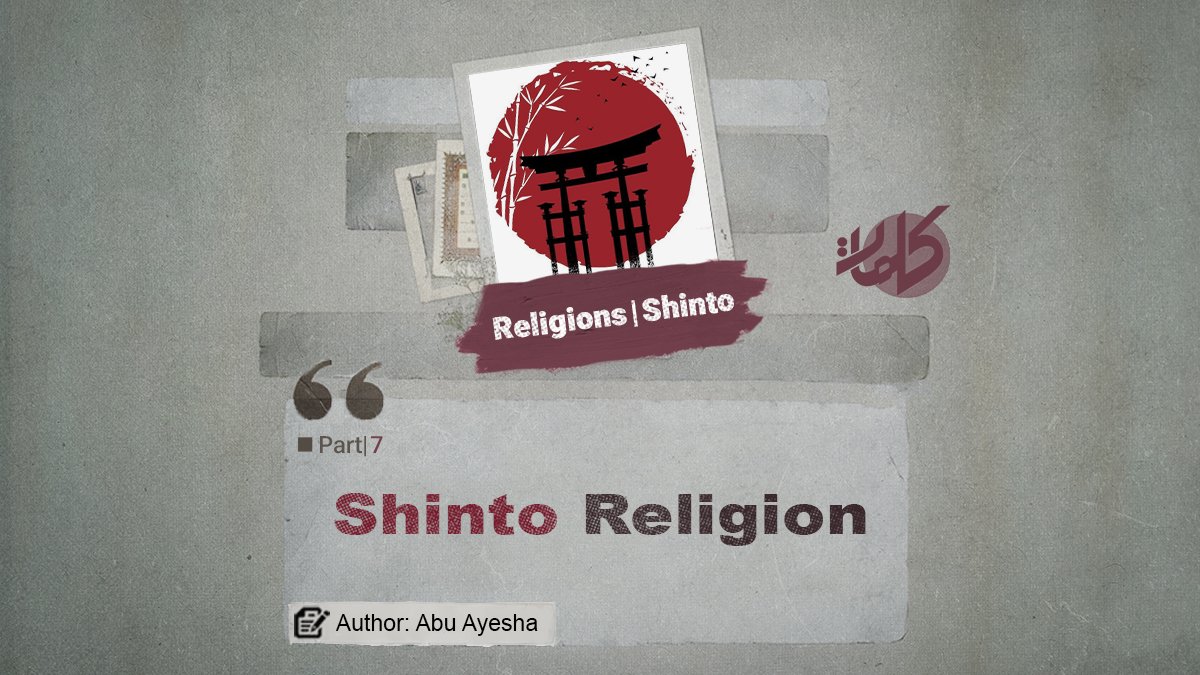Author: Abu Ayesha
Shinto Religion (Part 7)
Introduction
One of the most important kami in the Shinto religion, as previously mentioned, is the sun goddess Amaterasu. This kami and deity is highly valued and esteemed by the Japanese people, to the extent that they consider their great imperial lineage to have descended from this great kami and regard her as the symbol and embodiment of light, brightness, and the sun. However, understanding this kami — or, in the terminology of the Japanese people, deity — requires referring to certain myths and legends that have been common among the people, recorded in books of mythology and folklore, and transmitted orally.
The myths concerning the birth of the land of Japan and the tales related to the sun goddess have long been a political foundation, linking the Japanese imperial dynasty with the “Age of the Gods.” Therefore, a brief look at these myths, as they are recounted in ancient records and chronicles of Japan, will be useful and can greatly assist the reader in understanding the kami Amaterasu and her characteristics among the Japanese people.
The Emergence of the Gods and Their Rule
It is said that in the beginning, there was chaos and nothing else. From within it, a god (kami) appeared, followed by several generations of solitary deities and then paired male and female deities. Although the enumeration differs in two sources, there is consensus that Izanagi (“he who invites”) and Izanami (“she who invites”) were the seventh generation of kami and that they created the islands of Japan. From the suspended bridge of heaven, they looked down upon the sea, stirred the brine, and formed a small island on which they descended. From their union were born the islands of Japan, mountains, rivers, trees, grasses, grains, animals, and minerals.
When Izanami gave birth to the fire god, she was severely burned and died, descending to the land of the dead. Her husband Izanagi, overcome with grief, hastened to see her in the underworld. Izanami swore that if he refrained from looking at her until they escaped that world, they would return to the living; but curiosity overcame him, and Izanagi gazed upon her. Alas! He saw a hideous, decayed body. Ashamed of her appearance, Izanami grew angry, bore resentment against her husband, and pursued him. Izanagi fled from the underworld, sealed its entrance, and thus escaped. Because he had come into contact with death — considered defilement — he purified himself in a river. When he washed his left eye, Amaterasu, the sun goddess, was born. From his nose was born Susanoo, the god of winds, and when he washed his right eye, Tsukuyomi, the god of the moon, came into being. These three deities became known as the “August Offspring.” Izanagi granted heavenly rule to Amaterasu, dominion over the sea to Susanoo, and rulership of the night to Tsukuyomi.[1][2]
After understanding how the kami Amaterasu was born according to the myths and legends of the Japanese people, it is now better to introduce her more fully, examining her attributes and qualities in their tradition.
Amaterasu, in Japanese mythology, is the sun goddess and one of the most prominent deities in the Shinto religion. She is the symbol of light, life, and cosmic order, and it is said that the Japanese imperial dynasty descends from her. This goddess holds great esteem among the Japanese people and is one of their most revered kami.
Amaterasu is the most distinguished kami in Shinto history, receiving heightened attention particularly from the Edo period onward. This attention, however, was not out of concern for monotheism, but rather because of her connection to the emperor. The main shrine of Amaterasu is located at Ise, with its origins dating back to around 300 CE.[3]
Amaterasu, the sun goddess in Japanese mythology, is one of the most important figures in the Shinto faith. As the goddess of the sun and light, she plays a vital role in Japan’s mythological cosmos and, according to tradition, is regarded as the direct ancestor of the Japanese imperial family. She is considered one of the principal kami in Shinto mythology.[4]
This narrative persisted, and the myths were passed down from generation to generation, with the story of creation continuing until, after a long time, the first human appeared in the form of Japan’s first emperor, Jimmu, a descendant of Amaterasu.[5]
Amaterasu is regarded as the fundamental pillar of the divine legitimacy of the Japanese imperial family, for the people believe that the emperor directly descends from her. This belief grants the emperor a sacred status, making him a mediator between the gods and humankind. Ancient Shinto texts show that the emperor was seen as the living embodiment of Amaterasu, a perception that reinforced his religious and political authority. This connection highlights the role of religion in shaping Japan’s national identity, where the sun, as the symbol of Amaterasu, was considered the source of life and hope for the people.
Amaterasu continues to be worshiped in many official Shinto rituals, demonstrating her enduring influence on Japanese life. The bond between this goddess and the imperial family is not merely a historical myth but persists even in contemporary Japan, where Amaterasu is still honored as a living symbol of national unity and cultural heritage.[6]
All that has been said regarding the emergence of the kami, particularly the birth of Amaterasu, are but myths and legends; for myths play an important role in the worldview of the Japanese people. The Japanese regard myths with great reverence and value, attributing all that they possess to them. They connect the origins of their gods to these legends, recounting strange and irrational tales.
From these myths, deeply rooted in the Japanese people’s memory and consciousness, it becomes evident that they not only consider their emperors to be the direct offspring of the sun goddess Amaterasu, but also believe that all the islands and their inhabitants originated from a divine source. What is notable is that they consider this story unique to Japan and do not extend it to any other country. Hence, the worship of multiple deities (polytheism) is deeply rooted in their land, with the number of their gods beyond reckoning. Since ancient times, the Japanese have called their country the “Land of the Gods,” counting their deities into eighty groups, later expanded to seven hundred, each group including thousands of gods, with the sun goddess Amaterasu at their head.[7]
Continues…
Previous Part / Next Part
References
[1] Michiko Yusa, Japanese Religions, trans. Hassan Afshar, 1st ed., 2003 [1382 AH Solar], pp. 24–25.
[2] The myths and legends concerning the creation of these kami and their rulership of the earth are very extensive. To avoid excessive length, we have refrained from including them here.
[3] Alireza Ebrahim, Shinto: A View from Above, n.d., p. 92.
[4] “The Story of Amaterasu, the Sun Goddess in Japanese Mythology,” Roshanaei Magazine, collective authorship, published 2024 [1403 AH Solar].
[5] Alireza Ebrahim, Shinto: A View from Above, n.d., p. 91.
[6] Diane Abdellatif, “The Japanese Myth of Amaterasu: How the Sun Goddess Brought the World Out of Darkness,” Al-Majal, 2021.
[7] John Noss, A History of the World’s Religions, trans. Ali Asghar Hekmat, 3rd ed., 1975 [1354 AH Solar], with the collaboration of Franklin Publishing Institute, p. 279.



